Finding ways to boost productivity can feel like an endless quest. For example, did you know that Elon Musk schedules his day in 5-minute blocks to maximize efficiency?
But what if the secret to achieving more lies in something as simple as scheduling? Yes, you heard it right!
Scheduling is a game-changer, and this article will show you how are scheduling and productivity related and how it can help you transform your daily routine.
By organizing your tasks and managing your time effectively, you can reduce stress, avoid burnout, and accomplish more than you ever thought possible.
In this article, we'll delve into:
- Relationship between scheduling and productivity
- Various scheduling tips and techniques, and their impact
- A successful routine for optimal scheduling
- Productivity tips to maximize your time and energy
- Tools and apps to streamline scheduling
The Relationship Between Scheduling and Productivity
At its core, scheduling is the backbone of productivity, transforming chaotic workloads into a clear path toward achieving goals. It’s not just about filling calendar slots with tasks; it’s a deliberate strategy to align time, energy, and priorities for maximum impact.
Scheduling represents a strategic approach to managing your workload efficiently. By breaking down your projects into smaller, manageable chunks and assigning specific timeframes to each, you create a roadmap for success.
This detailed planning allows you to see the bigger picture while focusing on the immediate steps needed to reach your goals. Moreover, scheduling helps in prioritizing tasks based on their importance and urgency, ensuring that you tackle the most critical aspects first.
How Scheduling Helps Enhance Productivity
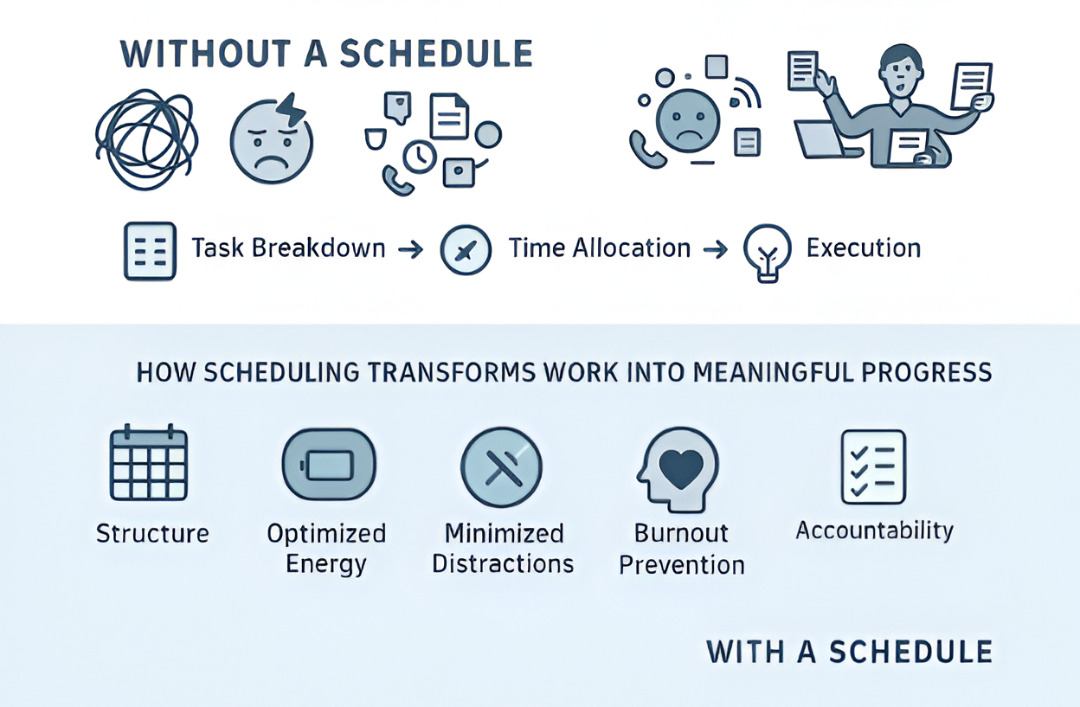
Implementing a well-structured schedule can dramatically improve productivity by providing clarity, focus, and balance to your day.
Here are some key benefits of scheduling for productivity:
- Provides Structure: Scheduling helps create a clear roadmap for your day, reducing uncertainty and keeping tasks on track.
- Resource Optimization: Scheduling accounts for peak energy levels and team availability, ensuring tasks are tackled when performance is at its best.
- Minimizes Distractions: Having a set schedule helps you avoid multitasking and limits distractions, enabling deeper focus.
- Prevents Burnout: By incorporating breaks into your schedule, you can maintain energy levels and avoid fatigue.
- Increases Accountability: Sticking to a schedule holds you accountable to your plan, making it easier to track progress and stay productive throughout the day.
💡Consider a real-world example: A project manager handling a local search campaign for a small business might waste time juggling client emails, Google My Business updates, and competitor keyword analysis without a schedule. A clear plan assigns tasks to specific times. Mornings for creative work like content planning, afternoons for client communication, driving efficiency, preventing burnout, and building client trust with consistent results.
Time Management and Its Role in Productivity
Effective time management is a key component of productivity, and scheduling is a powerful tool for managing your time. By setting realistic deadlines and timeframes for your tasks, you can allocate your resources wisely.
Time management helps you balance competing demands, eliminate procrastination, and make progress towards your goals. With proper scheduling, you can avoid last-minute rushes and ensure that you have enough time to complete each task efficiently.
In addition to enhancing work efficiency, time management through scheduling also promotes a sense of accomplishment and motivation. As you tick off completed tasks from your schedule, you experience a sense of progress and achievement, fueling your drive to tackle the remaining items on your list.
This positive reinforcement loop created by scheduling can boost your morale and overall job satisfaction, leading to sustained productivity levels over time.
Different Types of Scheduling Techniques
Scheduling techniques play a crucial role in time management, helping individuals and teams make the most of their available time. By implementing effective scheduling strategies, you can prioritize tasks, allocate resources efficiently, and meet deadlines with ease.
Here are some popular and actionable scheduling techniques to enhance your productivity:
Prioritizing Tasks: The Eisenhower Matrix
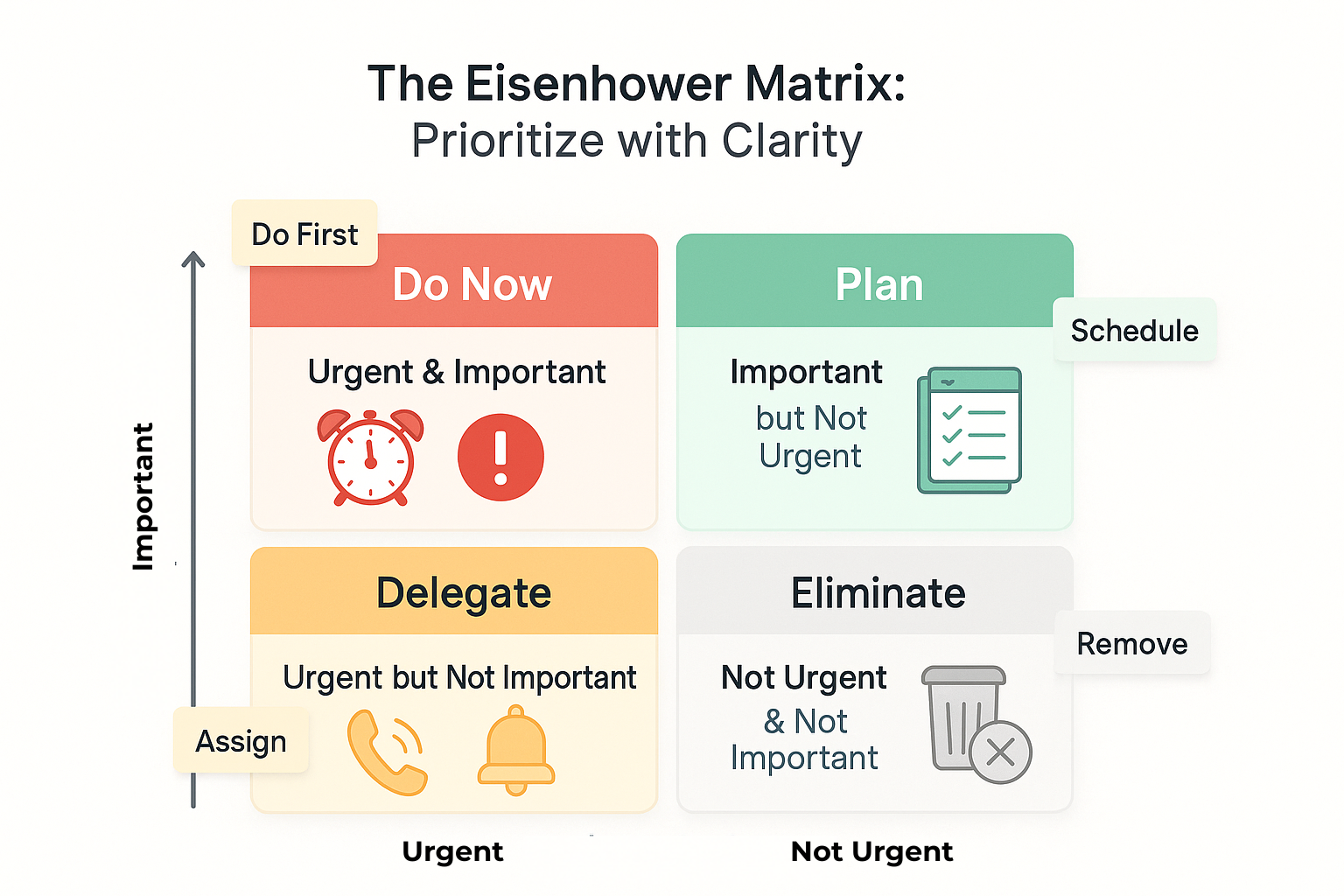
The Eisenhower Matrix, also known as the Urgent-Important Matrix, is a powerful tool for prioritizing tasks. It involves categorizing your tasks into four quadrants based on their urgency and importance.
This visual representation helps you make informed decisions about where to focus your time and energy, ensuring you address the most critical responsibilities first.
Steps to Use the Eisenhower Matrix:
- List all your tasks: Write down everything you need to accomplish.
- Categorize tasks:
- Urgent and Important: Tasks that need immediate attention and have significant consequences if delayed.
- Important but Not Urgent: Tasks that are crucial for long-term goals but do not require immediate action.
- Urgent but Not Important: Tasks that need quick attention but are not critical to your goals.
- Not Urgent and Not Important: Tasks that have little impact and can often be eliminated.
By differentiating between what is urgent and what is important, you can avoid getting overwhelmed and concentrate on tasks that align with your goals and priorities.
The Pomodoro Technique: Breaking Work into Intervals
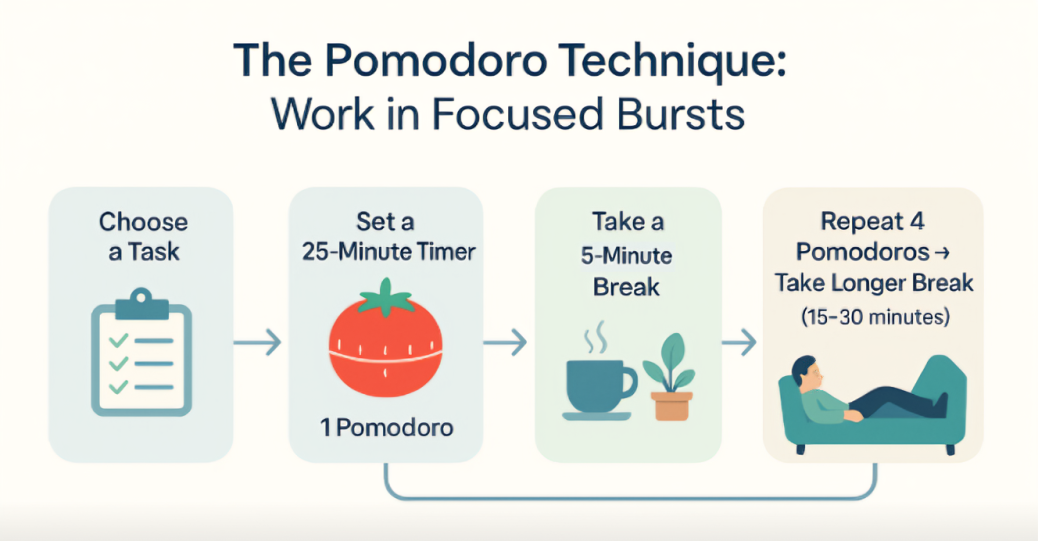
The Pomodoro Technique is a time management method that breaks work into intervals, typically 25 minutes long, separated by short breaks.
This technique helps you maintain concentration and energy levels, prevent burnout, and increase overall productivity. It's simple yet effective, keeping you engaged and making progress on your tasks.
How to Implement the Pomodoro Technique:
- Choose a task you want to work on.
- Set a timer for 25 minutes (one Pomodoro).
- Work on the task until the timer rings.
- Take a short break (5 minutes).
- Repeat the process for four Pomodoros, then take a longer break (15-30 minutes).
Named after the tomato-shaped kitchen timer its creator, Francesco Cirillo, used, the Pomodoro Technique is based on the idea that breaking work into manageable chunks can improve focus and productivity. Regular breaks help rest and recharge, promoting sustainable work habits in the long run.
Implementing a Successful Scheduling Routine
Establishing a successful scheduling routine is not just about organizing your time; it's also about understanding your own working style and preferences.
By aligning your schedule with your natural rhythms, you can optimize your productivity and overall well-being.
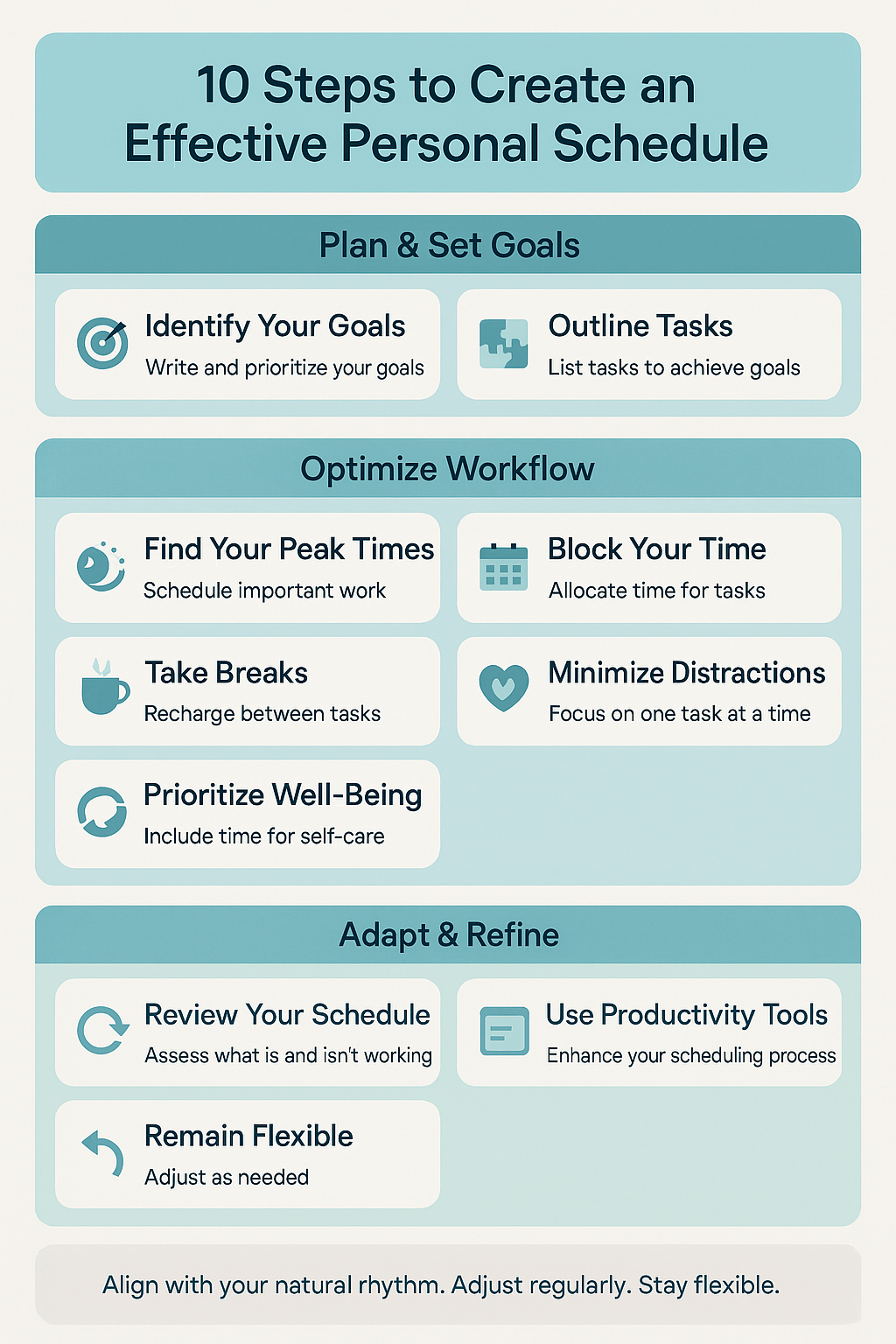
Create an Effective Schedule in 10 Simple Steps
Creating an effective schedule is essential for maximizing productivity and maintaining a healthy work-life balance. Follow these actionable steps to craft a schedule that works for you:
1. Identify Your Goals:
- Write down your short-term and long-term goals.
- Prioritize these goals based on importance and urgency.
2. Break Down Goals into Actionable Steps:
- Divide each goal into smaller, manageable tasks.
- Assign realistic deadlines to each task to ensure steady progress.
3. Determine Your Peak Productivity Hours:
- Reflect on when you feel most energetic and focused during the day.
- Schedule your most critical tasks during these peak hours.
4. Allocate Time Slots for Different Activities:
- Assign specific time slots for each task, ensuring you have enough time to complete them.
- Include buffer time to accommodate any unexpected interruptions or delays.
5. Incorporate Regular Breaks:
- Schedule short breaks between tasks to rest and recharge.
- Plan longer breaks after extended periods of work to prevent burnout.
6. Experiment with Scheduling Methods:
- Try different scheduling techniques like the Pomodoro Technique or time blocking.
- Find the method that best suits your working style and preferences.
7. Include Self-Care Activities:
- Dedicate time blocks for activities that promote physical and mental well-being, such as exercise, meditation, or hobbies.
- Prioritizing self-care ensures you stay refreshed and motivated.
8. Review and Adjust Regularly:
- Evaluate your schedule periodically to see what’s working and what’s not.
- Make necessary adjustments to stay aligned with your evolving goals and priorities.
9. Use Digital Tools for Efficiency:
- Utilize digital planners or scheduling apps to organize and manage your tasks.
- Set reminders and notifications to keep track of your deadlines and commitments.
10. Stay Flexible and Adaptable:
- Be prepared to adjust your schedule as needed to handle unforeseen events.
- Maintain a growth mindset and remain open to refining your scheduling practices.
By following these steps, you can create an effective schedule that aligns with your natural rhythms, optimizes your productivity, and supports your overall well-being.
Overcoming Common Scheduling Challenges
Navigating the intricacies of scheduling can be daunting, particularly when unanticipated events or interruptions disrupt your plans. The key to mastering scheduling lies in cultivating flexibility and adaptability.
Here are some tips for effective scheduling to help you overcome common challenges and boost productivity:
Embrace Flexibility and Adaptability
- Stay Open to Change: Understand that plans can change unexpectedly. Being open to adjustments can reduce stress and help you stay on track.
- Delegate Wisely: Recognize tasks that can be delegated to others. This will free up your time for more critical responsibilities.
- Seek Support: Don't hesitate to ask for assistance when needed. A collaborative approach can often yield better results.
Avoid Overloading Your Schedule
- Prioritize Tasks: Focus on what's most important and urgent. Use prioritization techniques such as the Eisenhower Matrix to categorize tasks effectively.
- Include Buffer Time: Allocate extra time between tasks to account for unforeseen delays. This will help prevent your schedule from becoming too rigid.
- Set Realistic Goals: Be honest about what you can achieve in a given timeframe. Overcommitting can lead to burnout and decreased productivity.
Utilize Technology for Efficiency
- Scheduling Apps: Digital calendar tools help organize tasks and appointments, sending timely reminders to keep priorities on track. These apps sync across devices, ensuring access to schedules anywhere, anytime.
- Time Management Tools: Software that tracks time usage provides insights into work patterns, enabling data-driven adjustments to optimize efficiency and focus on high-value tasks.
- Task Automation: Automation tools handle repetitive tasks, such as sending routine updates or organizing data, freeing up time for critical priorities and reducing mental clutter.
Develop a Growth Mindset
- Learn from Mistakes: View scheduling mishaps as learning opportunities rather than failures. Reflect on what went wrong and how you can improve.
- Adapt and Evolve: Stay open to new methods and tools. Continuous improvement is key to mastering time management and scheduling.
- Stay Positive: Maintain a positive outlook even when things don't go as planned. A constructive attitude can help you navigate challenges more effectively.
By incorporating these scheduling tips into your routine, you can overcome obstacles and enhance your overall productivity. Remember, the goal is not to create a perfect schedule but to develop a flexible framework that accommodates life's unpredictabilities.
Tools and Apps to Aid Scheduling
In today's digital age, numerous tools and apps provide help with scheduling, making it easier to organize your time and boost productivity. Let’s explore a few popular options:
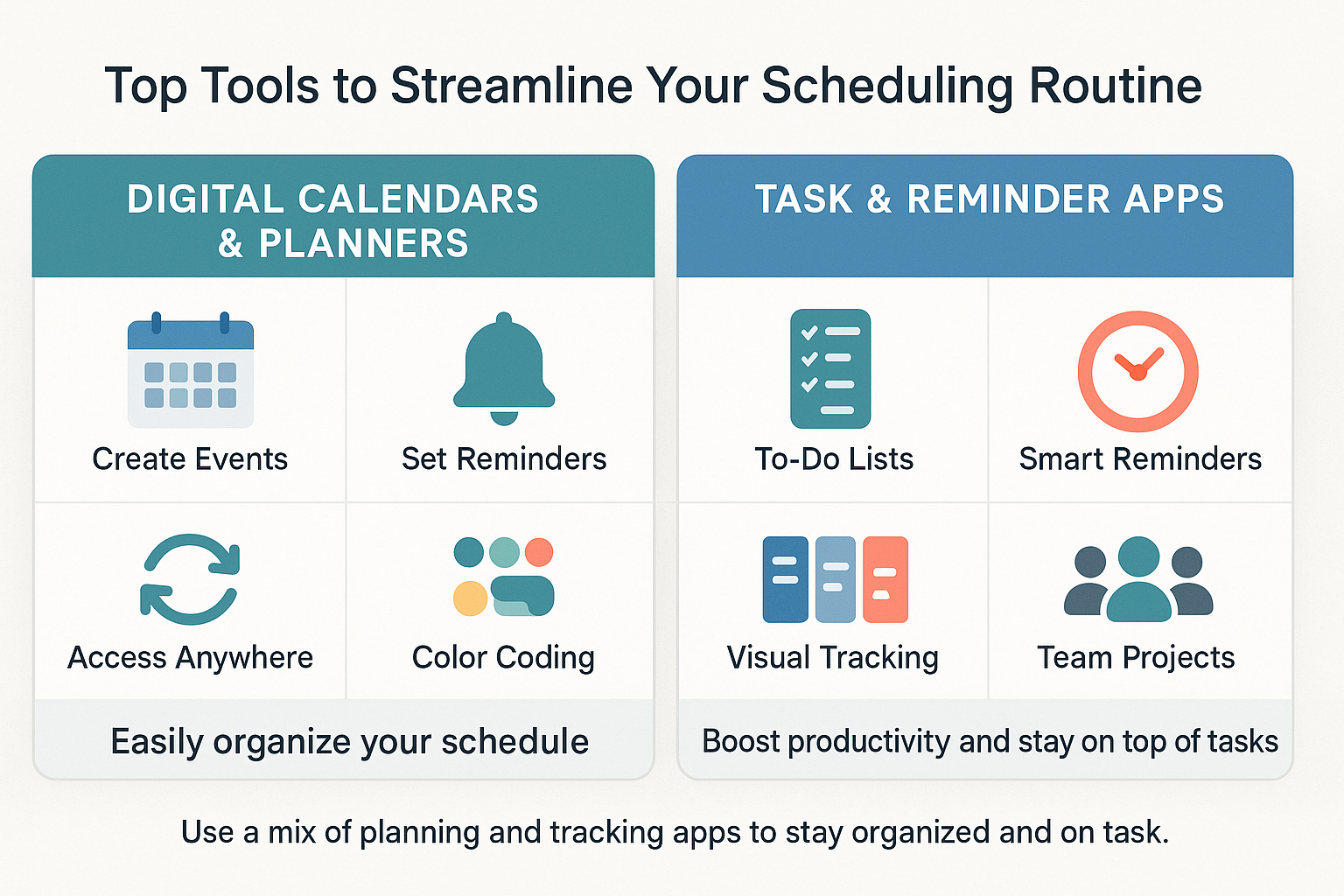
Digital Calendars and Planners
Digital calendars and planners offer a user-friendly interface for organizing and planning your schedule. You can easily:
- Create events: Quickly create, edit, or delete events with a user-friendly interface
- Set reminders: Set customizable alerts for events, deadlines, or recurring tasks
- Share calendars: Share calendars with team members, family, or friends to coordinate schedules and plan joint activities effortlessly
These tools provide a seamless experience across multiple devices, ensuring that you can access and update your schedule wherever you are.
Moreover, digital calendars often come with advanced features such as:
- Color coding: Assign colors to different event types (e.g., work, personal, fitness) for quick visual identification.
- Recurring event options: Automate scheduling for repetitive tasks, such as weekly meetings or monthly reviews.
- Ability to attach files or notes to events: Attach documents, links, or detailed notes to events for easy reference, keeping all relevant information in one place.
These additional functionalities can help you categorize and prioritize your schedule effectively, making it easier to manage your time and commitments.
Task Management and Reminder Apps
Task management and reminder apps help you keep track of your tasks, deadlines, and priorities. These apps allow you to:
- Create dynamic To-Do Lists: Create and manage task lists with drag-and-drop prioritization to focus on what matters most.
- Set customizable Reminders: Set time- or location-based notifications to ensure you never miss a deadline or overlook a task.
- Collaborate with others on shared projects: Share tasks and projects with colleagues or group members, enabling real-time updates and seamless teamwork.
Furthermore, some task management apps offer features like Kanban boards, subtask organization, and progress tracking. These tools can increase your productivity by providing visual representations of your tasks and progress, making it easier to stay focused and motivated as you work through your to-do list.
Mastering Scheduling for Enhanced Productivity
So, at this point, it’s very clear how closely scheduling and productivity are related. Scheduling, when done in an efficient fashion, is more than just organizing your day. It's a strategic tool for maximizing productivity and achieving your goals.
By implementing techniques like the Eisenhower Matrix and the Pomodoro Technique and leveraging digital tools, you can transform how you manage your time. Prioritize tasks, align them with your peak productivity hours, and embrace flexibility to adapt to life’s uncertainties.
Incorporate regular breaks and self-care to maintain balance and avoid burnout. Regularly review and adjust your schedule to stay on track and continuously improve. Mastering these effective scheduling strategies will empower you to save time, accomplish more, and reduce stress, ultimately leading to a more productive and fulfilling life.
Frequently Asked Questions (FAQs)
What are the key objectives of effective scheduling?
Scheduling helps prioritize critical tasks, optimize resource use, and maintain work-life balance. It ensures deadlines are met without burnout by allocating time for breaks and self-care. It also fosters accountability, tracks progress, and adapts to changes, keeping teams focused on goals while minimizing stress.
Why is scheduling important for productivity?
The importance of scheduling lies in its ability to bring order to chaos, aligning tasks with goals. It cuts decision fatigue by mapping out what needs doing and when. Prioritizing high-impact tasks focuses energy on what matters, reducing stress and boosting output. Without a schedule, it’s easy to get sidetracked by low-value tasks or distractions.
How can I create a schedule that maximizes productivity?
Focus on aligning tasks with your energy cycles and long-term goals. Reserve your most productive hours for high-cognitive tasks like strategic planning or creative work.
Use the 2-Minute Rule to kickstart tasks: begin with a small, actionable step (e.g., drafting one sentence of a report) to overcome procrastination. Group similar tasks (e.g., emails, calls) into batches. Schedule weekly priority reviews to ensure your daily tasks align with bigger objectives.
How can I optimize my work schedule for maximum productivity?
Align tasks with energy levels to tackle complex projects when sharpest. Use time-blocking to dedicate uninterrupted periods to key tasks. Incorporate short breaks to sustain focus, as burnout tanks efficiency. Leverage digital tools for task tracking. Stay flexible to handle urgent issues without derailing the plan.
How does automated scheduling software enhance productivity for small businesses?
Automated scheduling tools streamline meeting coordination, cutting back-and-forth emails. They sync with calendars, avoid double-booking, and free up mental space for strategic work. For small teams, this means less admin overhead and more time for high-value tasks, driving efficiency.
How can I maximize productivity with a daily planner?
A daily planner turns vague goals into clear steps. Write down tasks, prioritize them using a method like the Eisenhower Matrix, and assign time slots. Digital planners sync across devices and send reminders. The act of writing or typing reinforces commitment, keeping focus sharp, and procrastination at bay.
How to schedule a productive day?
Begin the night before by listing 1-3 “must-do” tasks tied to your core goals, using the 80/20 Rule to focus on the 20% of tasks that yield 80% of results. Allocate these to your peak focus hours, identified through self-observation (e.g., when you feel most alert).
Use themed time blocks (e.g., “admin hour” for emails, “creative block” for ideation) to streamline focus. Schedule micro-breaks to refresh attention without disrupting flow. Reserve 10 minutes at day’s end to journal progress and flag incomplete tasks for rescheduling
How can every minute of the day be scheduled effectively?
Scheduling every minute sounds intense, but it’s about intentional time blocks, not micromanaging. Use time-blocking to assign specific tasks to 30-60 minute chunks. Leave buffers for unexpected interruptions. Tools with a calendar view can help you visualize the day. The key is balancing rigid structure with flexibility. Overplanning kills adaptability.
How to improve scheduling efficiency?
Use automation tools like scheduling apps to eliminate manual coordination and prevent double-booking. Consolidate tasks by grouping similar activities, such as meetings or administrative work, into dedicated time blocks to reduce context-switching. Regularly audit your schedule to identify and eliminate low-value tasks that clog your day. Leverage data from time-tracking tools to pinpoint inefficiencies and adjust your plan accordingly. Finally, set clear boundaries. Say no to non-essential commitments to protect your schedule’s focus.
Related Articles
How to Manage Project Budget Overspends: Stop the Bleed, Regain Control
How Do You Measure the Success of Project Collaboration: Build Alignment, Trust, and Results
Discover the future of Project Management
Bring AI-powered efficiency to your team’s project management


.png)
_light%201.png)





